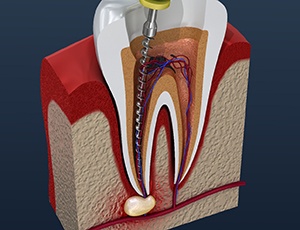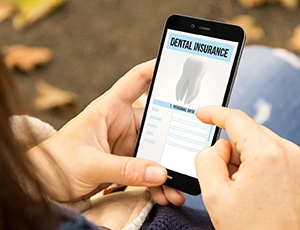Root Canal Therapy – Richardson, TX
Say Goodbye to That Toothache!
We admit that a root canal may not be a favorite pastime, but we’ll also bet it’s not as bad as you may think. The truth is that root canal therapy in Richardson is a fairly common procedure that is not uncomfortable or painful. In fact, a root canal eliminates the pain of an infected tooth, stops the spread of infection, and could prevent the need to have a tooth removed. If you’d like to schedule an appointment and get the prompt relief you deserve, continue reading or give our office a call today!
Do I Need Root Canal Therapy?

One of the hallmark symptoms of an infected tooth that needs a root canal is pain. As the bacterial infection inside your tooth grows, the trapped inflammation can cause excruciating pain.
Other signs that imply you may need a root canal include:
- Sensitivity to hot or cold foods and beverages
- Swelling on the side of your face
- Fever
- A pimple-like sore on the gum tissue near the painful tooth
- Discomfort with normal chewing and biting
Some people do not experience any discomfort or other outward signs of needing a root canal. However, the infection will show up on an X-ray, which is why regular dental checkups are so important. Your dentist may not only be able to spot infection, but prevent it and other dental problems with professional cleanings and scheduled examinations to detect a cavity sooner rather than later.
The Root Canal Process

It may surprise you to learn that the procedure is pretty straightforward! After administering a local anesthetic to the infected tooth and surrounding soft tissue, your dentist in Richardson creates an access hole through the biting surface. Then, using special hand instruments, the infected tissue and debris are removed from the tooth’s pulp chamber and root canals.
The interior of the tooth is disinfected and filled with an inert substance called gutta-percha, which expands in the hollow space to support the remaining tooth structure and prevent recontamination. Finally, the tooth is sealed, and a temporary crown is placed until your permanent one arrives at the office.
After root canal therapy, your dentist will likely give you a prescription for an antibiotic to ensure that the infection is completely eradicated. For a few days after therapy, the tooth may be sensitive. Try chewing on the other side of your mouth. For discomfort, an over-the-counter pain reliever such as ibuprofen or acetaminophen should suffice.
A couple of weeks following your procedure, you will need to return to the office to have a permanent dental crown placed over the tooth. This crown protects the remaining tooth structure and gives you the ability to chew and bite normally.
The Benefits of Getting a Root Canal

By choosing to get a root canal in Richardson, you can expect to enjoy multiple incredible benefits, such as:
- Tooth Preservation – Fixing your hurting tooth instead of extracting it will save you plenty of time, money, and pain down the line.
- Improved Oral Health – Since root canal therapy cleans out all of the harmful bacteria causing you pain, you can enjoy a beautiful, healthy smile right away.
- Virtually Pain-Free Treatment – Even though root canals have a bad reputation, they’re not as painful as you think! Most patients find it to be as comfortable as getting a standard filling. Plus, it requires less recovery time than a tooth extraction.
Understanding the Cost of Root Canals

Root canal therapy is often necessary to save your tooth, but does it fit into your budget? That can be a tricky question to answer since every procedure is different. We can go over the details of the treatment with you and help you understand the costs involved; that way, you won’t be caught off guard when the time comes to pay. And if you want to explore options for making root canal therapy more affordable – such as dental insurance – we can assist you with that as well.
Factors That Can Affect Root Canal Cost

Before we can figure out the exact cost of your root canal therapy, we need to examine the tooth or teeth in questions thoroughly. Once we understand your needs, we can give you a reliable estimate. Some of the variables that can affect the final amount you pay include:
- The type of tooth being worked on. For example, molars have more canals that need to be filled and thus are more costly to treat.
- The complexity of the treatment. More complex forms of root canal therapy tend to carry a higher cost.
- Any additional services. If a new dental crown needs to be placed on your tooth, it will be added to the overall cost.
Is it Cheaper to Pull My Tooth?

On the surface, it may look like having your tooth removed altogether is the less expensive option. However, there are hidden consequences to losing a natural tooth. For instance, your other teeth will start to shift out of place, changing your bite and making it harder to eat your favorite foods. You can replace an extracted tooth with a dental implant or bridge, but that will cost extra. In short, saving your natural tooth is often the most cost-effective option. Bear in mind that you don’t have long to make a decision; if you delay having root canal therapy performed for too long, the infection in your tooth may become severe enough that an extraction is needed anyway.
Does Dental Insurance Cover Root Canal Therapy?

Yes, most insurance plans will help pay for root canal therapy. It’s usually considered a major procedure, so you can typically expect your insurance company to cover about 50% of the cost. That said, some plans may pay up to 80% of the cost. It’s important to confirm your coverage with your insurance company beforehand so that you aren’t caught off guard later. Our team is more than happy to help with the process of filing claims on your behalf so that you can maximize your benefits.
Other Options for Making Root Canal Therapy Affordable

In addition to accepting dental insurance, we also take CHIP, Liberty, Dental Quest, and MCNA Medicaid plans. And for those who don’t have any form of coverage, we can offer low to no interest financing through CareCredit. By breaking up the cost of your root canal therapy into smaller monthly payments, you can remove a lot of stress from the process and take care of your wallet.
Root Canal FAQs

Have you been told that you’re in need of root canal therapy? You may have some unanswered questions about the procedure, so we’re here to help! Here are the answers to some of the most common queries we receive about root canals in Richardson. If you don’t see the information that you’re looking for below, just give us a call. We’d be happy to explain more about the procedure so you know what you can expect.
How Much Pain Is Normal After a Root Canal?
While the root canal procedure itself shouldn’t hurt, you may experience some soreness for the next few days. After the local anesthetic wears off, you’ll probably experience some sensitivity, but this is all temporary. Over-the-counter pain relievers, like ibuprofen, can help to manage this. Avoid hard foods, as this can worsen discomfort. Soreness should subside after three days. If it doesn’t, give us a call so we can help.
Can I Eat Before a Root Canal?
If you’re being sedated for your root canal, you may be asked to fast for a few hours beforehand in order to reduce the risk of nausea caused by the sedative. If you won’t be undergoing sedation, it’s recommended that you eat a healthy meal at least a couple hours before the procedure. Your mouth will be numb for a little while afterwards, making it difficult to eat. Avoid alcohol for 24 hours before the procedure, as it can interact negatively with the local anesthetic used to numb your mouth.
Do I Need Antibiotics Before or After My Root Canal?
Most patients don’t need to take antibiotics before or after getting a root canal. You will probably only be prescribed antibiotics before a root canal if you have a health condition that increases your risk of infection after a major dental procedure. We will go over your medical history beforehand to determine whether prescribing antibiotics for you is a good idea.
Are Root Canals Covered by Insurance?
Dental insurance primarily covers routine care, like checkups and cleanings, that could have prevented the need for a root canal. However, most dental insurance plans will cover a portion of the cost after you have paid your deductible and before you have reached your annual maximum. Root canal therapy is typically considered to be a major restorative procedure, so the cost is often covered at up to 50%.
